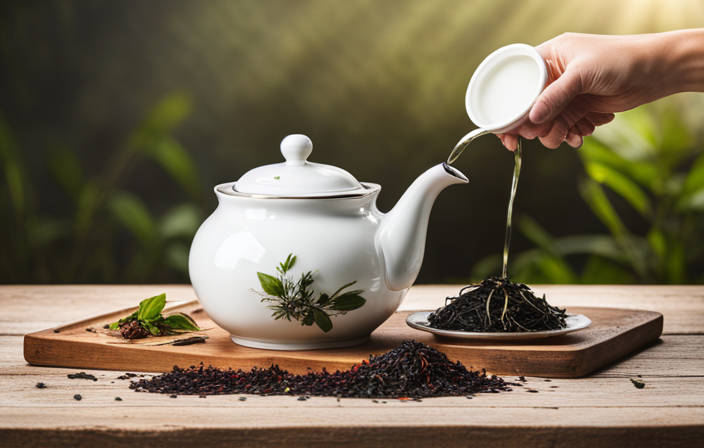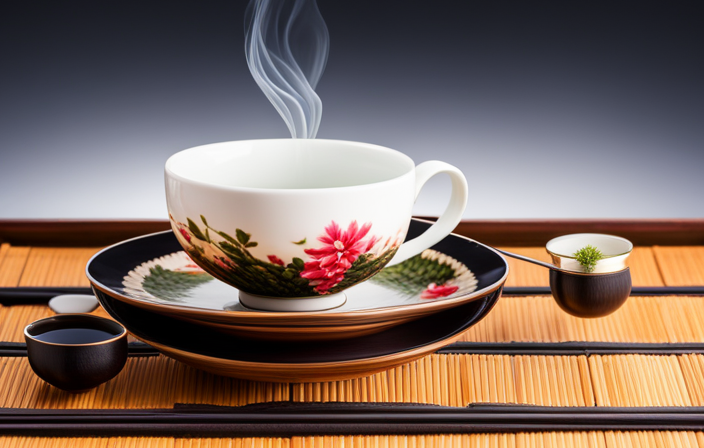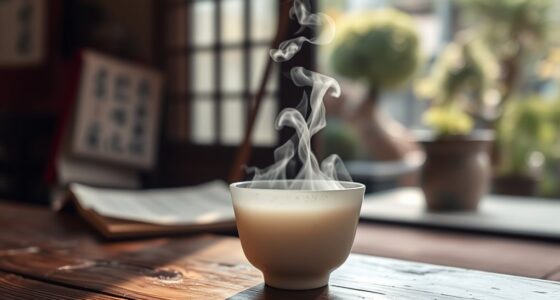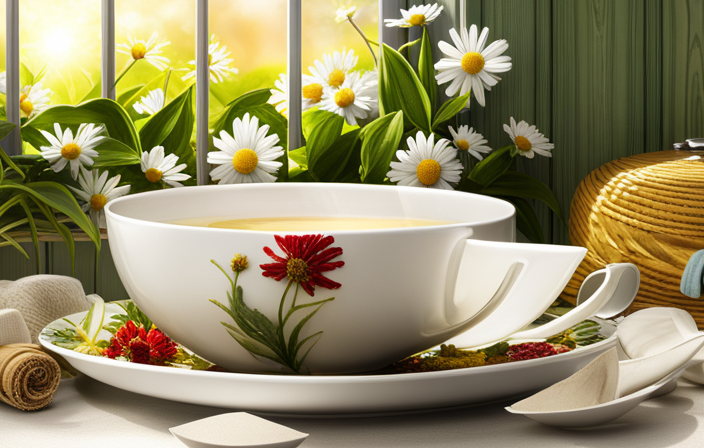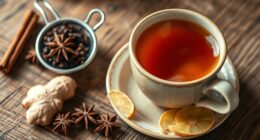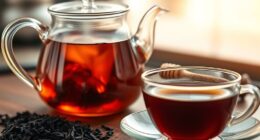I have found the key to making the ideal cup of tea, and it’s easier than you think.
In just seven easy steps, you can create a divine beverage that will awaken your senses and bring comfort to your soul.
From selecting the finest tea leaves to savoring every sip, this guide will show you how to master the art of tea brewing.
Get ready to impress and serve the most delightful tea to your guests.
Key Takeaways
- Tea grading classifies leaves based on quality, appearance, and flavor.
- Different types of tea require specific water temperatures for optimal brewing.
- Precision in measuring tea leaves and water ratio affects strength and flavor.
- Using the appropriate tea brewing techniques and equipment enhances the tea-drinking experience.
Selecting the Right Tea Leaves
I need to find the right tea leaves to make a perfect cup of tea. To do so, it’s crucial to understand the concept of tea grading and the different types of tea available.
Tea grading is a process that classifies tea leaves based on their quality, appearance, and flavor characteristics. The highest grade teas are typically made from the young and tender leaves, while lower grades may include larger, more mature leaves.
The different types of tea, such as black, green, oolong, and white, each undergo unique processing methods, resulting in distinct flavors and aromas.
Preparing the Water
To brew a perfect cup of tea, it’s essential to pay attention to the temperature and quality of the water. The water temperature plays a crucial role in extracting the true flavors of the tea leaves. Different types of tea require different water temperatures for optimal brewing.
For delicate teas like green and white tea, water that’s around 175°F to 185°F is ideal. On the other hand, black teas and herbal teas can tolerate higher temperatures, around 195°F to 205°F.
Boiling techniques are also important to consider. It’s best to bring the water to a rolling boil and then let it cool for a few seconds before pouring it over the tea leaves.
Additionally, the quality of the water used can greatly impact the taste of the tea. Ideally, one should use filtered or spring water to avoid any impurities that might alter the flavor.
Heating the Water to the Correct Temperature
Using a thermometer and a stovetop kettle, I can ensure that the water is heated to the correct temperature for brewing the tea. The process of heating the water is crucial in achieving the perfect cup of tea.
Different types of tea require different water temperatures to extract the optimal flavors and aromas. Green tea, for example, is best brewed at around 175°F, while black tea requires water heated to a rolling boil, around 212°F.
Measuring the Tea Leaves
When it comes to measuring the tea leaves, precision is key. The amount of tea you use will directly affect the strength and flavor of your brew.
It’s important to get the tea to water ratio just right, ensuring a perfect cup every time.
Proper Tea Leaf Measurement
I always use a tablespoon to measure the proper amount of tea leaves for my perfect cup of tea. The key to a delicious tea infusion lies in the brewing techniques, and measuring the right amount of tea leaves is crucial for achieving the desired flavor and strength. Using a tablespoon ensures consistency and accuracy in the brewing process.
The tablespoon allows me to scoop just the right amount of tea leaves, ensuring a balanced and flavorful cup every time. It’s important to remember that different types of tea require different measurements, so it’s essential to follow the recommended guidelines for each variety. By using a tablespoon as a standard measurement, I can easily adjust the quantity of tea leaves according to my taste preferences and the specific type of tea.
Now that we’ve measured the tea leaves, let’s move on to the next step: the tea to water ratio.
Tea to Water Ratio
Steeping my tea leaves in a one-to-one ratio with hot water guarantees a well-balanced and flavorful cup. This tea brewing technique allows the flavors to unfold perfectly, resulting in a delightful experience for anyone who enjoys a good cup of tea.
The tea flavor profiles are enhanced when the correct ratio is used, ensuring that the taste isn’t overpowering or weak. It’s important to note that different types of tea may require different ratios, so it’s essential to experiment and find the perfect balance for each variety.
Accuracy in measuring the tea leaves and water is crucial to achieve consistent results. By paying attention to the tea to water ratio, we can ensure that every cup is brewed to perfection, delivering a delightful tea experience to our guests.
Importance of Accuracy
Getting the tea to water ratio right is crucial in ensuring the accuracy of the measurement, which ultimately leads to a perfectly brewed cup of tea. The importance of precision in this step can’t be overstated, as it directly impacts the flavor of the final product. Here are five key points to consider when striving for accuracy:
- Use a reliable scale to weigh the tea leaves and water.
- Follow the recommended ratio for the specific type of tea you’re brewing.
- Pay attention to the water temperature, as different teas require different temperatures for optimal flavor extraction.
- Allow enough space for the tea leaves to expand and infuse properly.
- Be mindful of any additional ingredients, such as milk or sweeteners, that may affect the overall taste.
Achieving the correct tea to water ratio sets the stage for the next crucial step: steeping the tea for the perfect amount of time.
Steeping the Tea for the Perfect Amount of Time
I always set a timer to make sure I steep my tea for the perfect amount of time. Steeping techniques vary depending on the type of tea and personal preference. It’s important to understand the infusion time variations to achieve the desired flavor and aroma. Here is a handy table that outlines the recommended steeping times for different types of tea:
| Tea Type | Steeping Time |
|---|---|
| Green Tea | 1-3 minutes |
| Black Tea | 3-5 minutes |
| Herbal Tea | 5-7 minutes |
| Oolong Tea | 3-5 minutes |
| White Tea | 2-4 minutes |
These times are just a starting point, as you can adjust them to suit your taste. Remember, steeping too long can result in a bitter taste, while steeping too short may result in a weak flavor. By following these guidelines and experimenting with different steeping times, you’ll be able to brew the perfect cup of tea every time. Enjoy serving yourself and others a delightful cup of tea with the knowledge of steeping techniques!
Straining or Removing the Tea Leaves
After steeping the tea for the recommended amount of time, I strain out the tea leaves and enjoy my perfectly brewed cup. Straining the tea leaves is an essential step to ensure a smooth and enjoyable cup of tea.
Here are some alternative straining methods to consider:
- Tea Infuser: A small mesh ball or basket that holds the tea leaves while allowing the water to flow through.
- Tea Strainer: A fine mesh sieve that catches the tea leaves as you pour the brewed tea into your cup.
- Tea Filter Bags: Convenient disposable bags that hold the tea leaves and can be easily removed after steeping.
- French Press: Pressing the plunger separates the tea leaves from the brewed tea, giving you a clean cup.
- Traditional Chinese Tea Ceremony: Using a small tea strainer to remove the leaves before pouring the tea into cups.
By removing the tea leaves, you ensure a clear and refined taste in your cup of tea.
Now, let’s move on to the next section on how to enjoy your perfect cup of tea.
Enjoying Your Perfect Cup of Tea
When it comes to enjoying your perfect cup of tea, there are a few key points to keep in mind.
Firstly, consider the art of tea pairing, as certain teas pair exceptionally well with specific foods or flavors, enhancing both the taste of the tea and the accompanying dish.
Additionally, don’t overlook the relaxation benefits that tea can bring – taking a moment to savor the aroma, slowly sip the warm liquid, and let the soothing properties of tea calm your mind and body.
Tea Pairing Suggestions
I love pairing a hot cup of Earl Grey tea with a slice of lemon drizzle cake. The combination of the aromatic tea and the tangy sweetness of the cake is simply delightful.
As a tea enthusiast, I’ve explored various tea and food pairings to create the perfect harmony of flavors. Here are some suggestions to enhance your tea-drinking experience:
-
Matcha tea with dark chocolate: The earthy notes of matcha tea complement the rich and slightly bitter taste of dark chocolate.
-
Green tea with sushi: The light and refreshing taste of green tea cleanses the palate, making it the perfect accompaniment to sushi.
-
Chamomile tea with honey and toast: The soothing qualities of chamomile tea are enhanced by the sweetness of honey and the crunchiness of toast.
-
Rooibos tea with cheese: The sweet and nutty flavor of rooibos tea pairs well with a variety of cheeses, creating a unique and satisfying combination.
-
Peppermint tea with fresh fruit salad: The cooling sensation of peppermint tea complements the natural sweetness of fresh fruits, creating a refreshing and healthy treat.
Relaxation Benefits of Tea
Sipping on a warm cup of tea, I can feel my stress melting away and my body relaxing. The relaxation benefits of tea are well-known and have been enjoyed for centuries. Not only does tea provide a soothing experience, but it also offers numerous health benefits. Different types of tea have unique relaxation properties, making it easy to find the perfect cup for any mood or occasion. To illustrate this, let’s take a look at a table showcasing some popular types of tea and their relaxation properties:
| Tea Type | Relaxation Properties |
|---|---|
| Chamomile | Calming, sleep aid |
| Green Tea | Stress reduction, focus enhancement |
| Peppermint | Digestive relaxation, soothing aroma |
| Lavender | Anxiety relief, promotes relaxation |
| Lemon Balm | Mood enhancer, stress relief |
Frequently Asked Questions
What Are Some Common Mistakes to Avoid When Selecting Tea Leaves?
When it comes to selecting tea leaves, there are some common mistakes that people often make.
One of the biggest mistakes isn’t paying attention to the quality of the leaves. It’s important to choose leaves that are fresh and of high quality.
Another mistake isn’t considering the type of tea you want to brew. Different types of tea require different types of leaves.
Lastly, many people overlook the importance of storing tea leaves properly to maintain their freshness and flavor.
Taking these tips into consideration can greatly enhance your tea brewing experience.
How Can I Ensure That the Water Is at the Correct Temperature for Brewing Tea?
To ensure the water is at the correct temperature for brewing tea, I find it helpful to use a thermometer or a kettle with temperature settings.
It’s important to get the water just right, as different types of tea require different temperatures to bring out their flavors and aromas.
Is It Necessary to Measure the Tea Leaves Precisely or Can I Estimate the Amount?
I find that measuring the tea leaves precisely is important to ensure the accuracy of the flavor and strength of the brewed tea. Estimating the amount can lead to inconsistencies and may result in a less satisfying cup of tea.
What Are the Benefits of Steeping Tea for a Longer Period of Time?
When it comes to steeping tea for a longer period of time, the benefits are quite remarkable.
Not only does it enhance the flavor and aroma of the tea, but it also allows for a stronger infusion of the beneficial compounds found in the leaves.
The longer steeping time can extract more antioxidants, polyphenols, and other healthy substances, providing a nourishing and revitalizing experience.
Can I Reuse the Tea Leaves for a Second Steeping?
Yes, you can definitely reuse tea leaves for a second steeping. Reusing tea leaves is a great way to get the most out of your tea and save money.
When reusing, make sure to increase the steeping time slightly to extract the remaining flavors. The second steeping may have a slightly milder taste, but it can still be enjoyable.
Remember to store the used tea leaves properly to maintain their freshness for future use.
Conclusion
After following these 7 steps, you’ll have brewed the most extraordinary cup of tea imaginable. Each sip will transport you to a world of pure bliss, where flavors dance on your taste buds and warm your soul.
The meticulous attention to detail in selecting the right tea leaves, preparing the water, and steeping for the perfect amount of time guarantees a tea experience that’s unparalleled.
So sit back, relax, and indulge in the perfection that’s your cup of tea.

